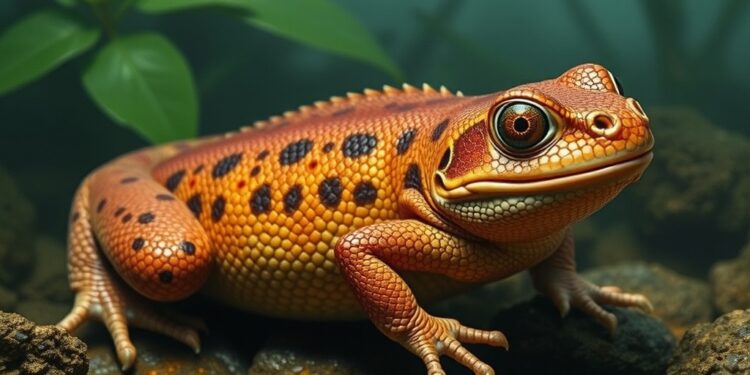
In a groundbreaking study, researchers from the University of Bristol have unveiled fascinating insights into how ancient frog relatives, known as temnospondyls, managed to not only survive but also flourish following the end-Permian mass extinction event, the most catastrophic extinction in Earth’s history. This event, which occurred approximately 252 million years ago, erased up to 90% of all species on the planet, creating an environment vastly inhospitable to life. Yet, against all odds, these amphibians adapted to the tumultuous changes of their Triassic environment, demonstrating a remarkable tenacity in the face of severe ecological upheavals.
The key to the temnospondyls’ success appears to be their generalist feeding ecology, which afforded them the ability to consume a varied diet. Unlike their strictly terrestrial counterparts, these amphibians predominantly thrived in freshwater ecosystems, which provided a relatively stable source of food amid the drastic environmental changes occurring at the time. By effectively exploiting aquatic prey that managed to evade terrestrial predators, temnospondyls were able to carve out a niche that would sustain them through otherwise challenging times. This adaptability undoubtedly contributed to their resilience, allowing them to thrive in the aftermath of one of the most devastating mass extinctions known to science.
During the Early Triassic, volatile volcanic activity precipitated significant climate changes, leading to conditions that were particularly harsh for ecosystems worldwide. This era was marked by prolonged global warming, aridification, and a series of cataclysmic events, including acid rain and wildfires, which devastated the tropical regions of the Earth. The resulting ‘tropical dead zone’ left vast areas devoid of animal life, thus radically altering the distributions of both marine and terrestrial organisms. The researchers aimed to elucidate how the temnospondyls managed to navigate such a hostile environment.
The study meticulously examined a diverse sample of 100 temnospondyls, taking into account variations in their body sizes and cranial features, which shed light on their feeding functions. To the surprise of the researchers, the findings revealed a striking stability in body size and morphology among these prehistoric amphibians throughout the crisis. Some temnospondyls were relatively small, primarily feeding on insects, while others developed larger bodies with specialized adaptations, such as elongated snouts for trapping fish or broader mouths as generalist feeders. This diversity in feeding strategy was pivotal in enabling them to exploit various ecological niches.
However, the most compelling aspect of the study was the evident expansion in body size diversity and functional range that occurred approximately five million years post-crisis, suggesting a brief but significant evolutionary response to the changing environment. This expansion, however, did not persist indefinitely, as it was followed by a notable decline. Such fluctuating patterns highlight the complex interplay between ecological factors and evolutionary trajectories that governed the lives of these ancient amphibians.
The findings also indicate a broader ecological shift, with evidence suggesting that, during intense global warming, terrestrial and marine life sought refuge from the extreme heat by migrating away from the tropics. In this context, the temnospondyls exhibited a noteworthy ability to traverse the tropical dead zone, with fossil records indicating their presence in diverse geographical locations such as South Africa, Australia, North America, Europe, and Russia. This adaptability was critical in ensuring their survival through periods when cooler episodic conditions allowed them to move across inhospitable terrains.
Lead author Aamir Mehmood encapsulated the essence of this discovery by underscoring the unexpected survival strategy of these amphibians. The dual capability of possessing a low food requirement coupled with an opportunist feeding strategy likely facilitated their endurance during the harsh Early Triassic conditions. This adaptability allowed temnospondyls to endure the precarious dynamics of their environment while smaller terrestrial predators faced significant food scarcity. Throughout this period, with broader access to aquatic resources and a lower competition threshold, these amphibians found themselves uniquely positioned to flourish.
However, this remarkable success was not destined to last. As we moved into the Middle Triassic, the evolutionary landscape began to shift once again. The diversification of early archosaurs—ancestors of dinosaurs and modern mammals—signaled a turning point for the temnospondyls. The rise of these new competitors signaled the beginning of a gradual decline in temnospondyl populations, illustrating how even the most resilient species can succumb to the broader patterns of evolutionary competition and ecological change.
The study serves as a reminder of the resilience of life in the face of extinction events and highlights the importance of ecological flexibility. The temnospondyls’ ability to adapt to rapidly changing environments underscores the role of biodiversity in survival. As the researchers continue to explore the nuanced relationships between extinct species and their ecosystems, the findings underscore an essential narrative within the broader context of evolutionary recovery following catastrophic events.
Ultimately, the research not only sheds light on the history of amphibians during one of the most tumultuous periods in Earth’s history but also provides critical insight into how environmental changes can drive evolutionary adaptations. The impressive resilience and subsequent decline of temnospondyls tell a compelling story of survival, adaptation, and the inherent fragility of life within the complex web of evolutionary history. As scientists delve deeper into the ecological past, future inquiries may offer even more profound revelations about the dynamics of life on Earth, guiding us in our understanding of ecological and evolutionary processes both ancient and modern.
This study, demonstrating the resilience and adaptability of ancient amphibians, paves the way for further exploration into how species respond to environmental catastrophes, thereby enriching our understanding of survival and evolution through times of profound change.
Subject of Research: Animals
Article Title: The ecology and geography of temnospondyl recovery after the Permian – Triassic mass extinction
News Publication Date: 4-Mar-2025
Web References: Royal Society Open Science
References: N/A
Image Credits: N/A
Keywords: Animal science, Amphibian evolution, Mass extinction, Triassic ecology, Temnospondyls.
Tags: amphibian resilienceancient frog relativesaquatic prey exploitationcatastrophic extinction eventsend-Permian mass extinctionenvironmental changes impactfreshwater ecosystems survivalgeneralist feeding ecologyprehistoric ecological adaptationspecies extinction recoverytemnospondyl amphibiansTriassic period adaptation





